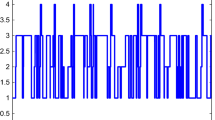Abstract
This paper mainly studies observability and detectability for continuous-time stochastic Markov jump systems. Two concepts called W-observability and W-detectability for such systems are introduced, which are shown to coincide with various notions of observability and detectability reported recently in literature, such as exact observability, exact detectability and detectability. Besides, by introducing an accumulated energy function, some efficient criteria and interesting properties for both W-observability and W-detectability are obtained.
Similar content being viewed by others
References
Damm T, On detectability of stochastic systems, Automatica, 2007, 43(5): 928–933.
Zhang W H and Chen B S, On stabilizability and exact observability of stochastic systems with their applications, Automatica, 2004, 40(1): 87–94.
Zhang W H, Zhang H S, and Chen B S, Generalized Lyapunov equation approach to statedependent stochastic stabilization/detectability criterion, IEEE Trans. Autom. Control, 2008, 53(7): 1630–1642.
Costa E F and do Val J B R, On the detectability and observability of discrete-time Markov jump linear systems, Systems & Control Letters, 2001, 44(2):135–145.
Costa E F and do Val J B R, On the observability and detectability of continuous-time Markov jump linear systems, SIAM Jour. Cont. Opt., 2002, 41(4): 1295–1314.
Li Z Y, Wang Y, Zhou B, and Duan G R, Detectability and observability of discrete-time stochastic systems and their applications, Automatica, 2009, 45(5): 1340–1346.
Li Z Y, Wang Y, Zhou B, and Duan G R, On unified concepts of detectability and observability for continuous-time stochastic systems, Appl. Math. Comp., 2010, {217}(2): 521–536.
Ni Y H, Zhang W H, and Fang H T, On the observability and detectability of linear stochastic systems with Markov jumps and multiplicative noise, Journal of Systems Science and Complexity, 2010, 23(1): 100–113.
Zhang W H and Tan C, On detectability and observability of discrete-time stochastic Markov jump systems with state-dependent noise, Asian J. Control, 2013, 15(5): 1366–1375.
Costa O L V and Fragoso M D, Stability results for discrete-time linear systems with Markovian jumping parameters, J. Math. Anal. Appl., 1993, 179(1): 154–178.
Ji Y D and Chizeck H J, Controllability, stabilizability, and continuous-time Markovian jump linear quadratic control, IEEE Trans. Autom. Control, 1990, 35(7): 777–788.
Feng X, Loparo K A, Ji Y D, and Chizeck H J, Stochastic stability properties of jump linear systems, IEEE Trans. Autom. Control, 1992, 37(1): 38–53.
Feng J E, Lam J, Xu S, and Shu Z, Stabilization of stochastic systems with optimal decay rate, IET Control Theory Appl., 2008, 2(1): 1–6.
Hager W W and Horowitz L L, Convergence and stability properties of the discrete Riccati oprator equation and the associated optimal control and filtering problems, SIAM J. Control Optim., 1976, 14(2): 295–312.
Chen B S and Zhang W H, Stochastic H2/H8 control with state-dependent noise, IEEE Trans. Autom. Control, 2004, 49(1): 45–57.
Huang Y L, Zhang W H, and Zhang H S, Infinite horizon linear quadratic optimal control for discrete-time stochastic systems, Asian J. Control, 2008, 10(5): 608–615.
Zhang W H and Chen B S, H-representation and applications to generalized Lyapunov equations and linear stochastic systems, IEEE Trans. Autom. Control, 2012, 57(12): 3009–3022.
Anderson B D O and Moore J B, Detectability and stabilizability of time-varying discrete-time linear systems, SIAM J. Control Optim., 1981, 19(1): 20–32.
Ugrinovskii V A, Observability of linear stochastic uncertain systems, IEEE Trans. Autom. Control, 2003, 48(12): 2264–2269.
Dragan V and Morozan T, Observability and detectability of a class of discrete-time stochastic linear systems, IMA J. Math. Control Info., 2006, 23(3): 371–394.
Author information
Authors and Affiliations
Additional information
This research was supported by the Natural Science Foundation of China under Grant No. 61174078, theResearch Fund for the Taishan Scholar Project of Shandong Province of China, the SDUST Research Fundunder Grant No. 2011KYTD105, and the State Key Laboratory of Alternate Electrical Power System withRenewable Energy Sources under Grant No. LAPS13018.
This paper was recommended for publication by Editor ZHANG Jifeng.
Rights and permissions
About this article
Cite this article
Tan, C., Zhang, W. On observability and detectability of continuous-time stochastic Markov jump systems. J Syst Sci Complex 28, 830–847 (2015). https://doi.org/10.1007/s11424-015-2253-y
Received:
Revised:
Published:
Issue Date:
DOI: https://doi.org/10.1007/s11424-015-2253-y



